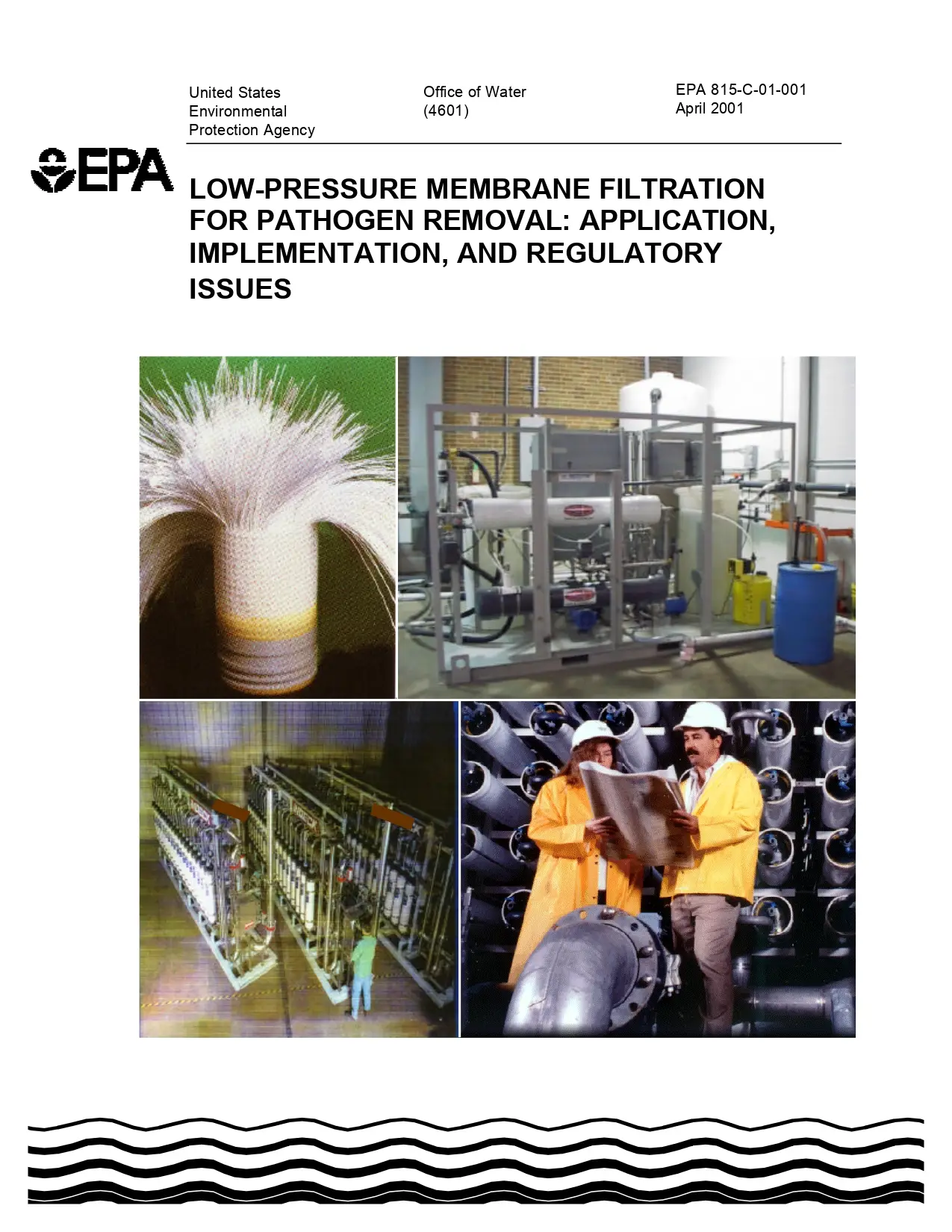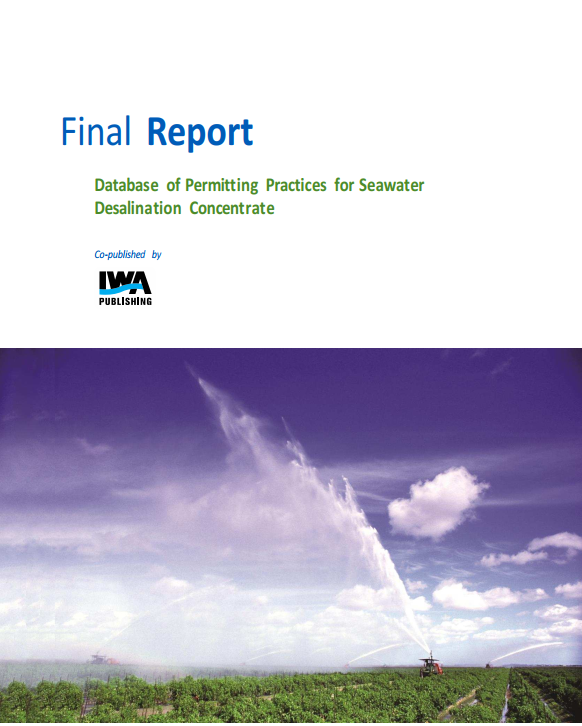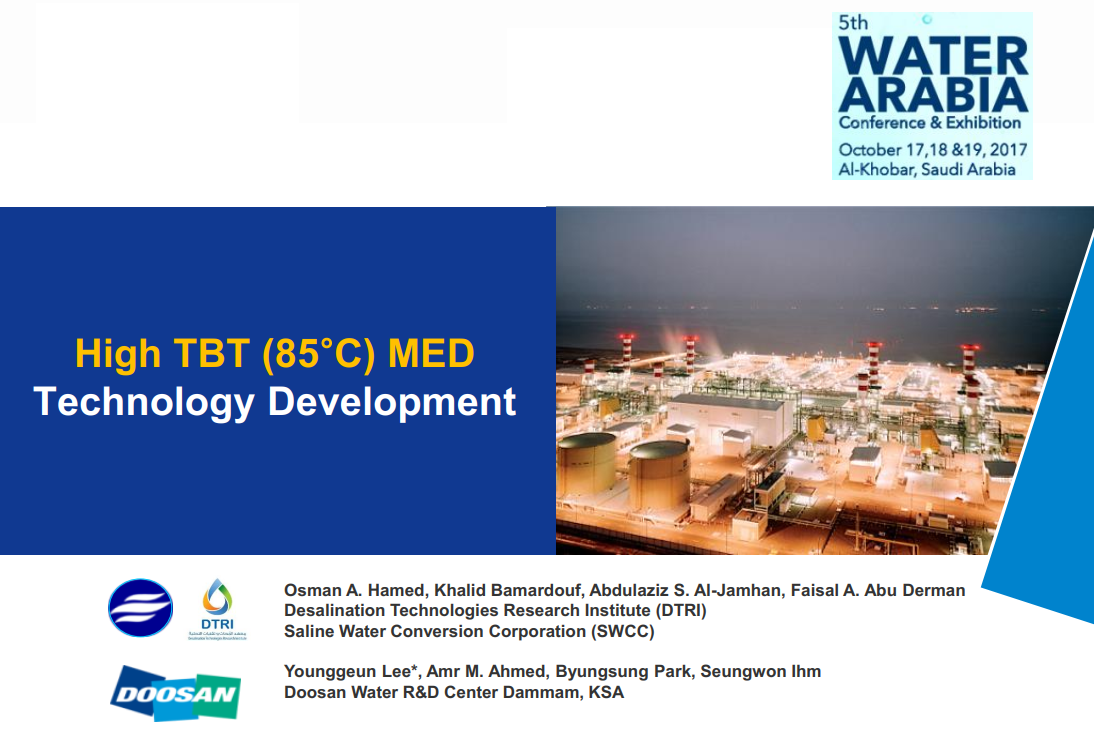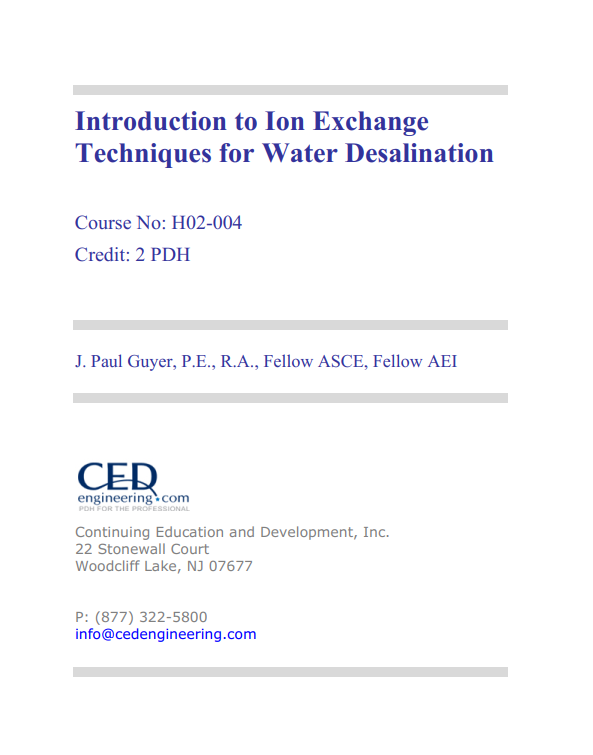Water Desalination & RO
Low-Pressure Membrane Filtration For Pathogen Removal: Application, Implementation, And Regulatory Issues
Views : 8
Source: https://www.epa.gov
Usually dispatched in 2 to 3 days
Usually dispatched in 2 to 3 days
Category:
Water Desalination & RO
Only logged in customers who have purchased this product may leave a review.
Related books
Desalination As An Alternative To Alleviate Water Scarcity And a Climate Change Adaptation Option In The MENA Region
This report has been prepared by Dr. Jauad El Kharraz at MEDRC with the support of Eng. Ayisha Al-Hinaai, Eng. Riadh Dridi, Ms. Elsa Andrews, Ms. Jackie Allison, and Eng. Georges Geha. This study was peer reviewed by three international experts. We would like to thank them for their reviewing work
Desalination As An Alternative To Alleviate Water Scarcity And a Climate Change Adaptation Option In The MENA Region
This report has been prepared by Dr. Jauad El Kharraz at MEDRC with the support of Eng. Ayisha Al-Hinaai, Eng. Riadh Dridi, Ms. Elsa Andrews, Ms. Jackie Allison, and Eng. Georges Geha. This study was peer reviewed by three international experts. We would like to thank them for their reviewing work
Desalination At A Glance
Introduction:
By desalination, we will be referring to the production of a useful product water from a feed
water that is too high in inorganic materials (salts) to be useful. The feed water may be
seawater, brackish water, or other “impaired” water that cannot be used directly for potable
or general industrial purposes. Notice that this definition includes the treatment of certain
wastewaters for subsequent reuse.
The principal technologies used in desalination are based on concepts that are fairly easy to
grasp by those with a modest amount of scientific training and/or technical experience. In
practice, however, choices of technology and plant design are usually determined by factors
that might appear minor to the inexperienced. Similarly, new technologies that show great
promise in the laboratory frequently fail for reasons that were earlier overlooked or dismissed
as trivial. Indeed, professional fascination with specific technical elegance has, in some
cases, led researchers to remain oblivious to inherent limitations of a process. Nonetheless,
attention to detail over the past five decades has resulted in dramatic reductions in capital
and operating costs as well as greatly increased plant reliability and performance
Desalination At A Glance
Introduction:
By desalination, we will be referring to the production of a useful product water from a feed
water that is too high in inorganic materials (salts) to be useful. The feed water may be
seawater, brackish water, or other “impaired” water that cannot be used directly for potable
or general industrial purposes. Notice that this definition includes the treatment of certain
wastewaters for subsequent reuse.
The principal technologies used in desalination are based on concepts that are fairly easy to
grasp by those with a modest amount of scientific training and/or technical experience. In
practice, however, choices of technology and plant design are usually determined by factors
that might appear minor to the inexperienced. Similarly, new technologies that show great
promise in the laboratory frequently fail for reasons that were earlier overlooked or dismissed
as trivial. Indeed, professional fascination with specific technical elegance has, in some
cases, led researchers to remain oblivious to inherent limitations of a process. Nonetheless,
attention to detail over the past five decades has resulted in dramatic reductions in capital
and operating costs as well as greatly increased plant reliability and performance
A Primer On Brackish And Seawater Desalination
Abstract: This publication was produced as an activity of the Texas Living Waters Project. This project
is a collaborative effort of the National Wildlife Federation, Environmental Defense, and the Lone
Star Chapter of the Sierra Club. The goals of the project are to 1) ensure adequate water for people
and environmental needs, 2) reduce future demand for water and foster efficient and sustainable use
of current water supplies, 3) educate the public and decision makers about the impact of wasteful
water use and the opportunities for water conservation, and 4) involve citizens in the decision
making process for water management.
A Primer On Brackish And Seawater Desalination
Abstract: This publication was produced as an activity of the Texas Living Waters Project. This project
is a collaborative effort of the National Wildlife Federation, Environmental Defense, and the Lone
Star Chapter of the Sierra Club. The goals of the project are to 1) ensure adequate water for people
and environmental needs, 2) reduce future demand for water and foster efficient and sustainable use
of current water supplies, 3) educate the public and decision makers about the impact of wasteful
water use and the opportunities for water conservation, and 4) involve citizens in the decision
making process for water management.
Cleaning Procedures for Composite Polyamide RO Membrane Elements
Note: The Composite Polyamide type of RO membrane elements may not be
exposed to chlorinated water under any circumstances. Any such exposure may
cause irreparable damage to the membrane. Absolute care must be taken
following any disinfection of piping or equipment or the preparation of cleaning or
storage solutions to ensure that no trace of chlorine is present in the feedwater to
the RO membrane elements. If there is any doubt about the presence of chlorine,
perform chemical testing. Neutralize any chlorine residual with a sodium bisulfite
solution, and ensure adequate mixing and contact time to accomplish complete
dechlorination. Dosing rate is 1.8 to 3.0 ppm sodium bisulfite per 1.0 ppm of free
chlorine
Cleaning Procedures for Composite Polyamide RO Membrane Elements
Note: The Composite Polyamide type of RO membrane elements may not be
exposed to chlorinated water under any circumstances. Any such exposure may
cause irreparable damage to the membrane. Absolute care must be taken
following any disinfection of piping or equipment or the preparation of cleaning or
storage solutions to ensure that no trace of chlorine is present in the feedwater to
the RO membrane elements. If there is any doubt about the presence of chlorine,
perform chemical testing. Neutralize any chlorine residual with a sodium bisulfite
solution, and ensure adequate mixing and contact time to accomplish complete
dechlorination. Dosing rate is 1.8 to 3.0 ppm sodium bisulfite per 1.0 ppm of free
chlorine
Desalination and Water Treatment
Abstract:
This study proposes a simple design method of the Reverse osmosis (RO) system in RO brackish water desalination plants. This method is based on the application of maximum available recovery without scaling of any of the compounds present in the water as silica, calcium carbonate, calcium sulfate, barium sulfate, strontium sulfate, and calcium fluoride, and membrane manufacturer design guidelines, and the plant production. Although the method was originally
conceived for application to subterranean brackish waters in the Canary Islands, Spain (principally Gran Canaria, Fuerteventura and Tenerife), it can be extrapolated to other types of region and water treatable with RO systems. The required input data are the chemical composition of the feed water, pH, temperature, silt density index membrane manufacturer design guidelines, and the plant production. The programmed method then determines the design of the RO system. The method whose procedure is described graphically and analytically can be used as an aid in design optimization of RO brackish water desalination plants with acid-free pretreatment processes and only the use of scale inhibitor using spiral wound membranes. Practical applications are presented. The final results for different types of feed water and capacities are showed.
Desalination and Water Treatment
Abstract:
This study proposes a simple design method of the Reverse osmosis (RO) system in RO brackish water desalination plants. This method is based on the application of maximum available recovery without scaling of any of the compounds present in the water as silica, calcium carbonate, calcium sulfate, barium sulfate, strontium sulfate, and calcium fluoride, and membrane manufacturer design guidelines, and the plant production. Although the method was originally
conceived for application to subterranean brackish waters in the Canary Islands, Spain (principally Gran Canaria, Fuerteventura and Tenerife), it can be extrapolated to other types of region and water treatable with RO systems. The required input data are the chemical composition of the feed water, pH, temperature, silt density index membrane manufacturer design guidelines, and the plant production. The programmed method then determines the design of the RO system. The method whose procedure is described graphically and analytically can be used as an aid in design optimization of RO brackish water desalination plants with acid-free pretreatment processes and only the use of scale inhibitor using spiral wound membranes. Practical applications are presented. The final results for different types of feed water and capacities are showed.
Database Of Permitting Practices For Seawater Desalination Concentrate
Abstract:
The purpose of this research project was to identify the discharge information that permitting agencies need and the decision-making process they go through to permit discharge methods in order to help desalination project proponents focus and expedite their permitting efforts.
The project documented seawater reverse osmosis (SWRO) discharge regulatory issues and provided a critical overview of facility discharge-related information required for permitting desalination projects in the United States and selected countries with advanced environmental regulations and experience in implementing seawater desalination projects. Information was gathered from the three key U.S. states (California, Florida, Texas) where interest in SWRO desalination has been highest. Due to the more extensive international experience with SWRO desalination, information was also obtained from the countries of Australia, Israel, and Spain – all countries of significant recent large-scale SWRO desalination projects. Case studies of 11 SWRO plants and analysis of regulatory systems and permitting processes supported detailed definition of the decision-making process to set discharge permit limits, as well as defining environmental and other regulatory issues associated with concentrate regulation.
Database Of Permitting Practices For Seawater Desalination Concentrate
Abstract:
The purpose of this research project was to identify the discharge information that permitting agencies need and the decision-making process they go through to permit discharge methods in order to help desalination project proponents focus and expedite their permitting efforts.
The project documented seawater reverse osmosis (SWRO) discharge regulatory issues and provided a critical overview of facility discharge-related information required for permitting desalination projects in the United States and selected countries with advanced environmental regulations and experience in implementing seawater desalination projects. Information was gathered from the three key U.S. states (California, Florida, Texas) where interest in SWRO desalination has been highest. Due to the more extensive international experience with SWRO desalination, information was also obtained from the countries of Australia, Israel, and Spain – all countries of significant recent large-scale SWRO desalination projects. Case studies of 11 SWRO plants and analysis of regulatory systems and permitting processes supported detailed definition of the decision-making process to set discharge permit limits, as well as defining environmental and other regulatory issues associated with concentrate regulation.
Tailoring Advanced Desalination Technologies for 21st Century Agriculture
Abstract: Substantial parts of the U.S., particularly drier landlocked regions, are facing acute water shortages and water quality issues that decrease agricultural productivity. Reduced crop yields cause billions of dollars in losses annually, affecting the livelihoods of thousands. A combination of population growth, inefficient agricultural practices, and resource demanding consumption trends is only expected to increase pressure on our water supplies. This research proposal seeks to address water and food security issues by cost-effectively and energy-efficiently enhancing water quality and water supply in greenhouses; a $22.93 billion dollar industry in 2017 that is rapidly growing at an annual rate of 8.92%. Greenhouses widely practice desalination of salty irrigation water to improve their operations. However, currently used desalination methods do not tailor greenhouse waters based on crop requirements. This work investigates a fully integrated desalination solution that treats and tailors brackish source waters ingreenhouses to save fertilizer and water. Specifically, this project experimentally studies multi-ion transport in and assesses the economic viable of monovalent selective electrodialysis (MSED). MSED allows for the selective removal of monovalent ions damaging to crops and the retention of divalent ions beneficial for crops, unlike the widely used reverse osmosis (RO), which removes all ions from greenhouse source water. First, we evaluate the techno-economic feasibility of MSED compared to other brackish desalination technologies for agricultural applications, based on primary market research we conduct with over 70 greenhouses.
These include conventional technologies, such as reverse osmosis (RO) and electrodialysis (ED), and advanced technologies, such as closed circuit reverse osmosis (CCRO). The analysis determines the levelized costs of water, the capital costs and energy requirements of these technologies, and how these vary with feed salinity, system capacity and recovery ratio. Then, we build a bench-scale setup to experientially characterize MSED membrane properties, including monovalent selectivity, ion transport, limiting current and resistance, for multiple brackish feedwaters and for two sets of MSED membranes: the widely used Neosepta ACS/CMS membranes and the new Fujifilm Type 16 membranes. Both MSED membranes show notable monovalent selectivity for all tested compositions, reflecting the potential of the technology for selective desalination in greenhouses. The measurements are compared to a model for MSED in multi-ion solutions. The model predicts multi-ion transport for the Neosepta and Fujifilm MSED systems within 6% and 8%, respectively.
Tailoring Advanced Desalination Technologies for 21st Century Agriculture
Abstract: Substantial parts of the U.S., particularly drier landlocked regions, are facing acute water shortages and water quality issues that decrease agricultural productivity. Reduced crop yields cause billions of dollars in losses annually, affecting the livelihoods of thousands. A combination of population growth, inefficient agricultural practices, and resource demanding consumption trends is only expected to increase pressure on our water supplies. This research proposal seeks to address water and food security issues by cost-effectively and energy-efficiently enhancing water quality and water supply in greenhouses; a $22.93 billion dollar industry in 2017 that is rapidly growing at an annual rate of 8.92%. Greenhouses widely practice desalination of salty irrigation water to improve their operations. However, currently used desalination methods do not tailor greenhouse waters based on crop requirements. This work investigates a fully integrated desalination solution that treats and tailors brackish source waters ingreenhouses to save fertilizer and water. Specifically, this project experimentally studies multi-ion transport in and assesses the economic viable of monovalent selective electrodialysis (MSED). MSED allows for the selective removal of monovalent ions damaging to crops and the retention of divalent ions beneficial for crops, unlike the widely used reverse osmosis (RO), which removes all ions from greenhouse source water. First, we evaluate the techno-economic feasibility of MSED compared to other brackish desalination technologies for agricultural applications, based on primary market research we conduct with over 70 greenhouses.
These include conventional technologies, such as reverse osmosis (RO) and electrodialysis (ED), and advanced technologies, such as closed circuit reverse osmosis (CCRO). The analysis determines the levelized costs of water, the capital costs and energy requirements of these technologies, and how these vary with feed salinity, system capacity and recovery ratio. Then, we build a bench-scale setup to experientially characterize MSED membrane properties, including monovalent selectivity, ion transport, limiting current and resistance, for multiple brackish feedwaters and for two sets of MSED membranes: the widely used Neosepta ACS/CMS membranes and the new Fujifilm Type 16 membranes. Both MSED membranes show notable monovalent selectivity for all tested compositions, reflecting the potential of the technology for selective desalination in greenhouses. The measurements are compared to a model for MSED in multi-ion solutions. The model predicts multi-ion transport for the Neosepta and Fujifilm MSED systems within 6% and 8%, respectively.
Basics of Reverse Osmosis
What is Reverse Osmosis?
Reverse Osmosis is a technology that is used to remove a large majority of contaminants from water by
pushing the water under pressure through a semi permeable membrane. This paper is aimed towards an audience that has little of no experience with Reverse Osmosis and will attempt to explain the basics
in simple terms that should leave the reader with a better overall understanding of Reverse Osmosis technology and its applications.
Basics of Reverse Osmosis
What is Reverse Osmosis?
Reverse Osmosis is a technology that is used to remove a large majority of contaminants from water by
pushing the water under pressure through a semi permeable membrane. This paper is aimed towards an audience that has little of no experience with Reverse Osmosis and will attempt to explain the basics
in simple terms that should leave the reader with a better overall understanding of Reverse Osmosis technology and its applications.















Reviews
There are no reviews yet.